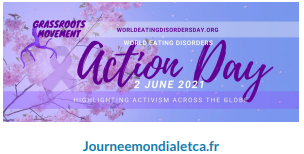World Eating Disorders Day
Source : Nutriactis/Rouen-Normandie hospital
Summary
- ED: definition
- The history of ED
- The World Eating Disorders Day
- What care for ED?
- The NUTRIACTIS® program
ED: definition
Eating Disorders are characterized by significant disturbances in eating behavior, which can lead to multiple complications, both somatic and psychological, associated with inadequate concerns about the body image. They include anorexia nervosa, bulimia nervosa and binge eating disorders.
The history of ED
- The origin of ED is still unclear, they seem to exist for many years, however the words “anorexia” and “bulimia” were not yet defined. The first cases of anorexia would date back to the 17th century with the “fasting girls”, young girls who fascinated the public by their refusal to feed themselves for a long period to show their devotion to religion. It was not until 1873 that the word “anorexia” appeared in medical publications and began to be considered as a real pathology.
- Precise definitions appeared in 1980 in the DSM-3, for anorexia and bulimia mainly then for BED and atypical ED. The DSM or Diagnostic and statistical manual of mental disorders is the reference manual for the classification of these disorders. Since 2013, the DSM-5 is the ED classification reference.
The 3 main categories of ED
- Anorexia nervosa (AN)
Characterized by a restriction of energy intake relative to requirements, an intense fear of gaining weight and a distorted perception of weight or body image (dysmorphophobia)
- Bulimia Nervosa (BN)
Characterized by a feeling of lack of control over eating, associated with binge eating episodes , recurrent compensatory behaviors (vomiting, taking laxatives…) and weight-dependent self-esteem.
- Binge eating disorder (BED)
Characterized by episodes of binge eating without compensatory behavior with possible tachyphagia (eating in a rush), lack of control over eating, ingestion of large amounts of food without real hunger, eating alone because of feeling embarrassed, eating until feeling uncomfortable full.
- Atypical ED
Atypical ED includes ED forms that do not meet the full diagnostic criteria of the 3 categories previously defined.
A constantly increasing prevalence
The lifetime prevalence for well-defined ED4, which is the proportion of the population with an ED during its lifetime, is:
8,4 % For women
2,2 % For men
This prevalence could even increase to 20% for women and 15% for men, taking into account all broad categories of eating disorders.
- This increasing prevalence is explained by a raise in daily risk factors such as increased anxiety, poor sleep, excessive use of social networks, or less self-esteem.
- The COVID-19 health crisis has had a significant impact on the management of many conditions including ED. On the one hand, social isolation, reduced normal daily activities, excessive use of social networks and, on the other hand, decreased sleep and physical activity are risk factors that have greatly increased during this pandemic.
 The World Eating Disorders Day
The World Eating Disorders Day
- World ED Day 2021 is the 6th edition that has been organized. This year, more than 250 associations participated in this event all around the world and thousands of people shared their messages on social networks.
- The theme of this 6th edition of ED day was “Equity 4 Eating Disorders” highlighting the importance of taking action to ensure that all patients have equal access to care.
- Many of the volunteers involved have suffered from ED or have seen their loved ones suffer. Through sharing experiences, they can provide support and advices to patients and their families.
What care for ED?
- The care pathway is quite similar for the different eating disorders with a multidisciplinary care associating nutritional and psychiatric follow-up in particular. The treatment is initially outpatient and, in the event that it is not sufficient or when a diagnosis is too late, hospitalization in a specialized center or hospital is sometimes necessary.
- Early care is therefore essential in the context of these disorders. Indeed, it would allow to limit the appearance of comorbidities, to avoid a lengthening of the delay between the first symptoms and the diagnosis and therefore, to avoid a possible hospitalization, which would thus make it possible to optimize the care. By extension, early care of ED leads to shorter and therefore less costly expensive cares.
- The World BED Day shows the importance of early management for BED patients. The implementation of a program offering early screening and prevention and self-care tools to target audiences could help limit the care costs.
The NUTRIACTIS® program
The Nutriactis® program is a program for self-screening and self-care of eating disorders and obesity. The aim of this program is to allow early screening of these diseases with multiple consequences in order to limit their development by offering appropriate self-care tools. This program is develop as part of the partnership between CHU de Rouen and BNP Paribas Cardif.
Resources to learn more about World ED Day
- Worldeatingdisordersday.org
- The website of the association organizing World BED Day. You will find many articles on this day but also on BED with patient experiences.

The official website of the World BED Day in France organized by the FFAB. You will find the program of this day but also precise information on the different BED and their treatments.